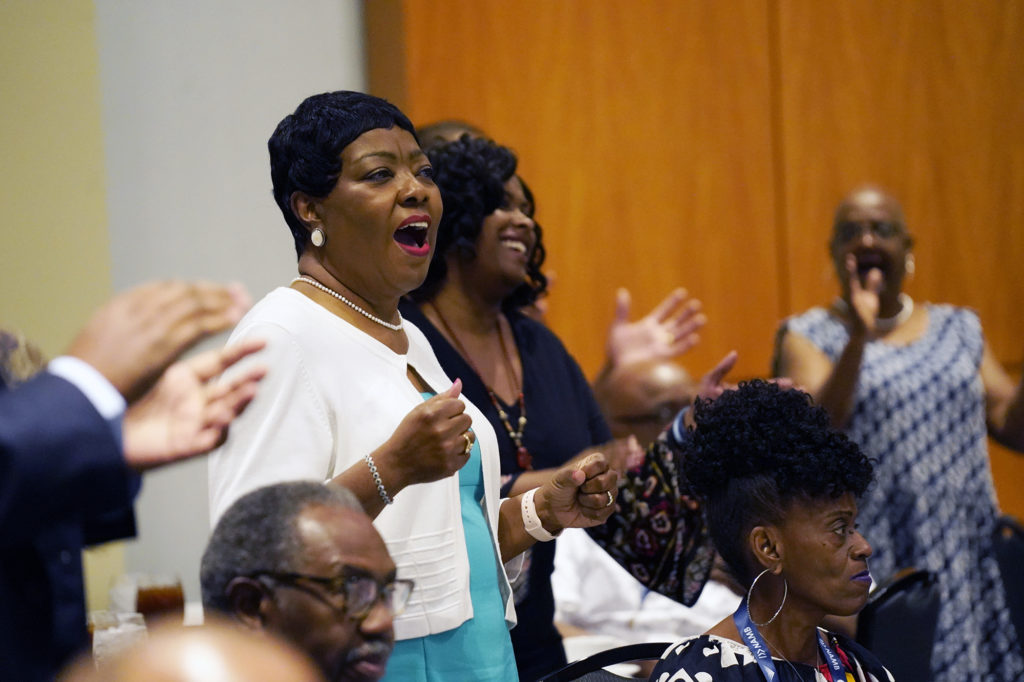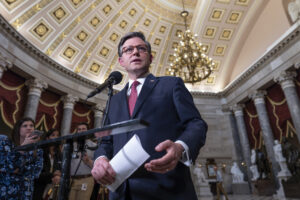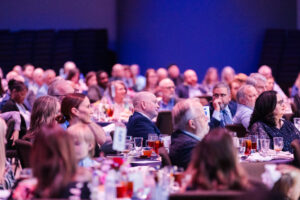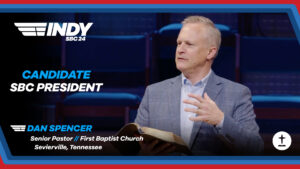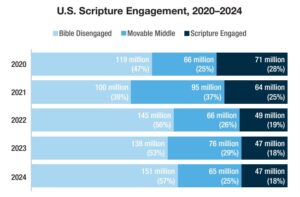
NASHVILLE (BP) – Alameda County, Calif., across the bay from San Francisco and including cities such as Oakland and Berkeley, probably wouldn’t be the first location Southern Baptists associate with a sign of the Convention’s future.
However, it contains 127 Southern Baptist congregations. That’s more than any county in Mississippi, Arkansas, Missouri or Louisiana. Oklahoma, Alabama and Georgia each have only one county numbering more. Another notable distinction for Alameda County – 44 of those congregations are African American, followed closely by 42 that are Asian American. Anglo congregations are a distant third at 24.
That’s not all. Five other California counties have more churches than Alameda – Los Angeles (593), San Diego (203), Orange (163), San Bernardino (133) and Riverside (133).
Those findings and much more can be discovered at the GCRM Ethnic Research Portal, unveiled to state convention leaders last week at their annual meeting. Accessing the information is free upon registering with the site.
Spearheaded by the SBC Great Commission Relations and Mobilization team, the initiative is a shared data collaboration of the Southern Baptist Research Fellowship and all six SBC seminaries as well as the Ethics & Religious Liberty Commission, GuideStone Financial Resources, the North American Mission Board, the International Mission Board, Lifeway Christian Resources and the SBC Executive Committee.
Although the SBC remains a largely Anglo Convention, trends over the last 20 years are impossible to deny when considering the future. From 2000-2010, sizeable increases in the number of congregations occurred among Hispanics (53.1 percent), African Americans (52.2 percent), Other Ethnics (49.3 percent) and Asian Americans (37.5 percent) while Anglo congregations grew by only 3.7 percent. Growth continued over the next 10 years, if at a slower pace, with Other Ethnic congregations growing by 33.2 percent, Asian American by 20.7 percent and African American by 10.2 percent. The number of White Anglo congregations decreased by 3.3 percent.
Furthermore, membership of ethnic minority groups increased by 1 million from 1990-2019 while Anglo groups decreased by the same amount. In that time span, 8 in 10 new SBC congregations were primarily made up of an ethnic minority.
‘A timely and needed resource’
The research tool is open to anyone and was designed to benefit the local church, said Minh Ha Nguyen, who has served as manager for Global Research at the IMB for more than 22 years.
“The GCRM Ethnic Research Portal helps churches know their community well, pray for unreached people groups in their city and build Great Commission relationships with other ethnic and language congregations in the SBC,” he said. “It allows local churches to get to know other Southern Baptists who speak different languages and build relationships across the cultural boundaries.”
Those tools can prove vital for churches, said Willie McLaurin. In December 2019, McLaurin was named vice president for Great Commission Relations and Mobilization at the SBC Executive Committee and most recently became the first African American to serve as CEO of a Southern Baptist entity upon being named interim EC president.
“I am incredibly thankful for the leadership of Minh Ha Nguyen and the Southern Baptist Research Fellowship for this grass roots resource,” he said. “The Collaborative Partnership of the Ethnic Research Network provides a timely and needed resource for the Southern Baptist Convention.
“The online platform provides a simple and easily accessible resource that will assist us in identifying, enlisting and expanding the ethnic footprint in our mission field. The portal developed by Southern Baptist mission-minded researchers will have an immediate and valuable impact on reaching the nations and the neighborhoods.
“The diversity represented in the SBC positions us for expanded cooperation and Gospel advance.”
The portal records that ethnic minority fellowships have a combined 11,287 congregations, making up nearly a quarter (22.3 percent) of the SBC. If they were separate state conventions:
- the African American fellowship would be the third largest, behind the Baptist General Convention of Texas and North Carolina
- the Hispanic convention would be fourth, behind the BGCT, North Carolina and Georgia
- the Asian American fellowship would be 10th, larger than Mississippi, South Carolina and Missouri.
The site includes interactive graphics that break down the research. Among the ten largest SBC associations, for instance, only Jacksonville has a majority of churches made up of one ethnic group (White Anglo). The other nine have no ethnicity exceeding 47 percent. A slider graphic also shows the change in the number of ethnic minority congregations across the country since 1990.
“According to our research on Ethnic Diversity Index (EDI), we, as Southern Baptists, are more diverse than we think we really are,” Nguyen said.
“In 1990, the EDI of SBC was 2.0 while the U.S. EDI was 5.4, with EDI=10 being the highest. In 2019, SBC EDI was 4.6 while the U.S. EDI was 7. In the 30-year span, SBC EDI gained 2.6 percentage points while the U.S. EDI gained 1.6 percentage points, a whole 1 point less than the SBC.
“This means that, while SBC is still less diverse than the U.S., it grows faster in diversity than the U.S.”
‘A long way to go’
While growth has occurred in diversity, the site also records the substantial decrease in baptisms among Southern Baptists over the last 20 years.
From 2000-2010, Hispanics were the only group to record an increase in baptisms at 12.5 percent. The SBC overall showed a 20.1 percent deficit in that time frame. According to the site, Southern Baptists reported a 62.8 percent drop in baptisms from 2010-2020, the highest decrease being among African American (82.6 percent) Native American (71.3 percent) and Hispanic (67.6 percent) congregations.
It’s difficult to overstate how the COVID-19 pandemic, societal unrest and the rising temperature over political discourse affected churches in 2020. Many congregations didn’t meet in person for several months, with numerous minority ethnic congregations choosing to gather only online for more than a year.
That is reflected in baptism numbers. In 2010, churches reported 332,321 baptisms, with that figure dropping to 246,442 in 2019. While still a 25.8 percent decrease, it shows the impact 2020 levied on baptism statistics for the decade.
Despite many churches not gathering in person, pockets of growth in the number of congregations continued among Asian Americans and Other Ethnics.
“The not-so-good-news is that COVID magnified the fragility of some of our ethnic groups,” Nguyen said. “The Hispanic group, for example saw the steepest drop in baptisms between 2019 and 2020 with a decrease of almost 64 percent and a decrease of 25 percent in worship attendance.”
A similar pattern occurred among Hispanic congregations during the economic recession of 2009. “We need, in the SBC, to help the most fragile groups build resilience and sustainability,” Nguyen said.
Todd Unzicker, executive director for North Carolina Baptists, expressed appreciation for the portal, while noting the challenge it spells out for Southern Baptists.
“I thank God for this new resource,” he said. “The studies show us that while Baptists have seen some improvement in the last 20 years, we all have a long way to go to be a Revelation 5 people.
“We must reflect not only the beauty of the coming Kingdom but also look like our mission field. The latest U.S. census tells us that 52 percent of people under the age of 18 are non-Anglo. We must reach this next generation.”
Kentucky Baptists’ executive director, Todd Gray, echoed those comments.
“The increasing diversity in Southern Baptist churches is one of the great untold stories of our convention,” he said. “The numbers reflect a Great Commission commitment to reaching everyone with the gospel of Jesus Christ.
“We are seeing a similar trend in Kentucky as an increasing number of our church plants are in diverse communities. As America becomes more diverse, so are our churches, and I’m excited for the future of the SBC. The faces in the congregations may change, but our message will always be the same – that there is salvation in no other name but Jesus.
“That is a message we want everyone to hear.”
A long time coming
The Ethnic Research Portal project contains information from SBC annuals going back 30 years and is the culmination of efforts going back more than a decade.
“Since 1990, ethnic and racially diverse congregations have increased … from 3.9 percent to 22.3 percent,” says the Report on Ethnic Diversity and Participation in the Southern Baptist Convention, found on page 171 of the 2021 SBC Annual. Information in the printed report largely mirrors that of the site, Nguyen said, but with the site containing updated figures.
That same report in the 2021 annual gives background on what led to the website. At the 2009 annual meeting Paul Kim, pastor emeritus of Antioch Baptist Church in Cambridge, Mass., made a motion for a study “regarding greater involvement of ethnic churches and leaders.” After being studied by workgroups for two years, Southern Baptists embraced the measure in a historic vote.
That 2011 initiative received a boost in 2019, when a motion passed by messengers and referred to the SBC Executive Committee asked for a progress report on diversity in the SBC. The EC’s response to that referral, adopted during its February 2020 meeting, included a goal to “monitor, solicit, and report such progress” through 2025 “so that the racial and ethnic diversity reflected among the Convention’s cooperating churches continuously becomes ingrained in Convention life and processes as our normal way of relating to and with one another as equal partners in ministry and brothers and sister in Christ.”
One of the strategic actions of Vision 2025, adopted by messengers last year, includes the elimination of all incidents of racial discrimination in churches. Former EC President Ronnie Floyd led in the formation of Vision 2025, but first built the GCRM team by bringing McLaurin on board alongside others in executive director roles – Julio Arriola, Hispanic relations; Peter Yanes, Asian American relations; Charles Grant, African American relations; and Ashley Clayton, church affiliation.
“Everything changed when [ethnic diversity] was highlighted by the EC,” Yanes said.
That team collaborated to collect the data that makes up the GCRM Ethnic Research Portal. Nguyen led in piecing the information together.
McLaurin asked Yanes to work with Nguyen on the project due to their longstanding friendship.
“The website has existed for a year or so, but this is the first time we’re sharing it with updated information,” Yanes said. “This is available not only to entities, but the local church.”
Data collection began shortly after Kim’s 2009 proposal for the diversity study, he said.
“If you go through the sections there is information related to missional engagement. This helps us to see where we are in terms of diversity and where there is an opportunity for Gospel impact.”
Nguyen told Baptist Press that it was important for the portal’s findings to reflect data points in the Annual Church Profile and other sources.
“Technically, the information on the site should be the same as what is in the SBC [printed] Annuals. The source of both is the Annual Church Profile (ACP) so this makes the GCRM Ethnic Research Portal trustworthy.
“What makes the site unique is, first, a greater granularity in terms of ethnicity and languages that is inclusive of some of the newer groups such as the Burmese and the Nepalese congregations. Second, the data on the site is standardized to the U.S. Census data, making comparability possible. This allows us, for example, to compare Southern Baptist diversity with the U.S. diversity at the national, state, county and city levels.
“Third, the graphic visualization of the data and communication of insights and trends on the web platform make the information accessible to a larger audience and to those who have leadership roles at all levels in the Convention. In other words, it is not intended for researchers only but for all leaders and practitioners at the entity, state convention, association and local church levels.”
Mission force, not mission field
As the number of ethnic said minorities has increased in SBC life, so has their participation in leadership. Former SBC President J.D. Greear gave diversity an elevated platform, appointing not only ethnic minorities but women to boards in greater numbers than ever before in the Convention’s history.
Nguyen estimates that hundreds of hours have been poured into making the site a reality. However, it’s more than worth it.
“I began to work on the GCRM Ethnic Research Portal with the purpose,” he said. “First, it is to tell the SBC story of ethnic diversity the way our ethnic fellowships and congregations want it to be told and second, to motivate our ethnic fellowships to partner with the larger SBC family for church planting and the Great Commission. …
“Ethnic minority leaders want to be considered as part of the mission force and not the mission field. The Great Commission belongs to them, too.”
